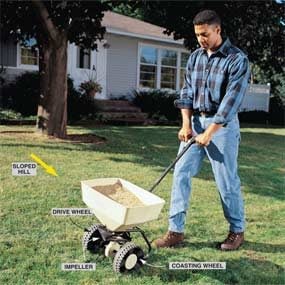Fall Lawn Care Guide
Updated: Nov. 16, 2021Ensure a greener yard in the spring by preparing your lawn in the fall

Fall Lawn Care: Aerate heavy soil
If you have heavy, clay-rich soil, it’s really important to aerate. Forget those gadgets that look like golf spikes that you strap to your shoes; rent a power aerator from any rental center for around $40 a day. The aerator extracts plugs from your lawn and topsoil to loosen compacted coil and break up thatch. Your lawn will look like a mess when you’re through but don’t worry, the plugs will dissolve in a few days. Don’t bother aerating if you have sandy soil–you’re just wasting your time. The time to aerate in colder climates is after dew begins forming in August. If you live in warmer, or more arid states aerate in the spring before warm-climate grasses go dormant in mid-summer. Mow your lawn and water it the day before aerating. Make two passes across the lawn with the aerating machine, perpendicular to each other, so that the aeration holes are spaced 2-3 in. apart.
Reseed bare patches
Late summer and early fall is the best time to reseed those dead areas. Summer is just too hot for the seed to thrive. Water the new seed a couple of times a day until the grass is around 1-1/2 in. high. Don’t use normal fertilizers, however. Use a product like Scotts Starter Fertilizer, which is designed for new grass. Spread the seed so that you have around 15 seeds per square inch. Don’t overdo it or the grass won’t thrive due to overcrowding.
Fertilize in the fall
When to Fertilize in Fall
Well after the grass appears brown and dormant, the roots are still hard at work absorbing nutrients and moisture. Just as bears gorge themselves before hibernating, your grass is storing up reserves to make it through the winter and thrive in the spring. Six to eight weeks before the first frost is when to fertilize the lawn in fall.
Set your broadcast spreader for half the recommended setting on the bag. Then make a “header strip” around the perimeter of the lawn. Next fertilize the entire lawn first in one direction, then the other (just as you did with the aerator). Be sure the shut off the spreader as you reach the spreader strip or you’ll over-fertilize the grass at the end of each pass.
Top 5 fertilizing tips
- Fill the spreader in the driveway, not on the lawn. You’re sure to spill and kill all of the grass that’s overexposed.
- Read and follow the coverage settings on the bag. You’re far better off under-fertilizing than over-fertilizing.
- Rinse out the spreader after use with a garden hose before putting it away. All of the metal parts will rust and freeze up if you don’t.
- Seal partial bags of fertilizer with duct tape and store them in a dry place. Otherwise, you’ll have a solid block of fertilizer next time you want to use it.
- If you’ve reseeded some areas, cover them with plastic before fertilizing the main lawn so you won’t burn the new seedlings.
Rake and mow
Get out that rake and remove all of those dead leaves before the snow flies. Otherwise they’ll be sodden mats in the spring and smother the sprouting grass below. (Plus it’s lots easier to rake dry leaves!)
Just this one time of the year, set your mower to cut 1-1/2 or 2-in. and mow your grass short. That’ll do a couple of things. First it’ll lessen the chance of snow mold forming. And secondly, tall grass blades won’t lie down and smother the new grass next spring.
Major lawn-care manufacturers, such as Scott’s, have a full line of fall lawn care fertilizers and other products to help you make your lawn the greenest yard in the neighborhood come spring.






